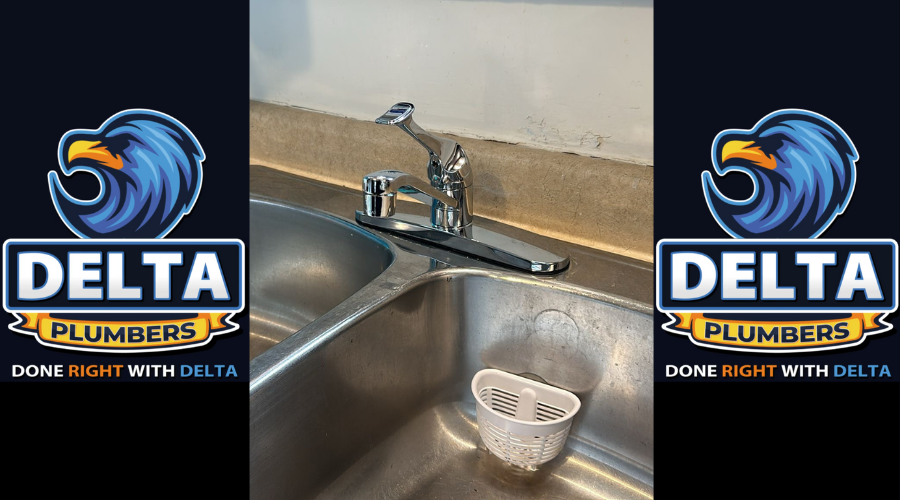When it comes to maintaining your home’s plumbing system, faucets play a crucial role. Whether you need to install a new faucet or repair an existing one, understanding the process can save you time and money. At Delta Plumbers, we aim to provide you with the best plumbing services and the knowledge you need to make informed decisions. In this comprehensive guide, we will cover everything you need to know about faucet installation.

Picture Source – Delta Plumbers
How Much Should I Pay for a Faucet Installation?
The cost of faucet installation can vary widely based on several factors, including the type of faucet, the complexity of the installation, and your location. On average, you can expect to pay between $150 and $350 for professional installation. This price range typically includes labor and basic materials.
High-end faucets or those with complex designs may increase the cost. If additional plumbing work is required, such as modifying existing plumbing or installing new connections, the price can go up. At Delta Plumbers, we offer transparent pricing and free estimates to help you budget for your faucet installation project.
Factors Influencing the Cost
- Type of Faucet: Basic models are cheaper, while luxury or high-tech faucets are more expensive. For instance, a standard kitchen faucet might cost less to install compared to a touchless or hands-free faucet that requires additional electrical work.
- Installation Complexity: Replacing an existing faucet is usually less expensive than installing a new one in a different location. If you need to move plumbing lines or modify your countertop, these tasks can add to the overall cost.
- Location: Prices can vary depending on your geographic location and the local cost of living. Urban areas with a higher cost of living tend to have higher labor costs compared to rural areas.
To give you a better idea, here are some average costs for different types of faucet installations:
- Standard Kitchen Faucet: $150 – $250
- Bathroom Faucet: $120 – $200
- Touchless Kitchen Faucet: $250 – $500
- Wall-Mounted Faucet: $200 – $400
At Delta Plumbers, we ensure competitive pricing and quality service, providing you with value for your investment.
Also Read: Drain Cleaning Plumbing Services in Ajax

Picture Source – Delta Plumbers
Do I Need a Plumber to Install a New Faucet?
While some homeowners may feel confident in their DIY skills, hiring a professional plumber to install a new faucet is often the best choice. A plumber ensures that the installation is done correctly, preventing potential leaks and water damage. They also bring expertise in handling unexpected issues that may arise during the installation process.
Benefits of Hiring a Professional Plumber
- Expertise and Experience: Plumbers have the necessary skills and knowledge to handle various types of faucets and plumbing systems. They can troubleshoot potential issues that an untrained eye might miss, ensuring a flawless installation.
- Proper Tools and Equipment: Professional plumbers use specialized tools to ensure a secure and leak-free installation. They have access to high-quality parts and materials that may not be available to the general public.
- Warranty and Guarantees: Many plumbers offer warranties on their work, providing peace of mind in case any issues occur post-installation. At Delta Plumbers, we stand by our work and offer a satisfaction guarantee to our clients.
Potential Risks of DIY Installation
- Incorrect Installation: An improperly installed faucet can lead to leaks, water damage, and even mold growth. Fixing these issues can be costly and time-consuming.
- Inadequate Sealing: Ensuring a watertight seal is critical in faucet installation. Professionals use high-quality sealants and know the correct techniques to prevent leaks.
- Voided Warranties: Some faucet manufacturers may void their warranties if the faucet is not installed by a licensed professional.
At Delta Plumbers, our team of licensed professionals is equipped to handle all your faucet installation needs, ensuring a hassle-free and efficient service. We take pride in our work and strive to exceed our customers’ expectations.
Also Read: Shower Drain Installation Services: Ultimate Guide by Delta Plumbers

Picture Source – Delta Plumbers
Is it Cheaper to Repair or Replace a Faucet?
Determining whether to repair or replace a faucet depends on the extent of the damage and the age of the faucet. In many cases, minor issues such as leaks or drips can be fixed with simple repairs, which are generally more cost-effective. However, if the faucet is old or has significant damage, replacing it may be a better long-term solution.
When to Repair
- Minor Leaks: Often caused by worn-out washers or seals, which are relatively inexpensive to replace. For example, a leaky faucet might just need a new O-ring or cartridge.
- Loose Handles: Usually fixed by tightening screws or replacing small parts. This type of repair is quick and doesn’t require specialized knowledge.
- Low Water Pressure: Sometimes due to mineral buildup, which can be cleaned. Removing aerators and soaking them in vinegar can often restore proper water flow.
When to Replace
- Frequent Repairs: If you find yourself constantly fixing the faucet, replacement may be more economical. Continuous repairs can add up and surpass the cost of a new faucet.
- Outdated Design: Replacing an old faucet can update the look of your kitchen or bathroom. Modern faucets come with features like water-saving technology and touchless operation.
- Major Damage: Cracks or significant wear and tear may warrant a new faucet. If the faucet body is damaged or corroded, it’s often better to replace it entirely.
Cost Comparison
- Repair Costs: Minor repairs can cost between $50 and $150, depending on the parts needed and the labor involved.
- Replacement Costs: As mentioned earlier, new faucet installations can range from $150 to $350. While the upfront cost is higher, a new faucet can save you from ongoing repair expenses.
At Delta Plumbers, we can help you assess the condition of your faucet and recommend the best course of action. Our goal is to provide cost-effective solutions that meet your needs and preferences.
Also Read: Bathroom Sink Backing Up Service by Delta Plumbers: A Complete Guide

Picture Source – Delta Plumbers
Can You Change a Faucet Without Turning Off the Water?
Turning off the water supply is a crucial step in any faucet replacement or repair. Attempting to change a faucet without shutting off the water can lead to significant water damage and flooding. Always turn off the water valves located under the sink or, if necessary, the main water supply to your home before starting any work.
Steps to Safely Change a Faucet
- Turn Off the Water Supply: Locate the shut-off valves under the sink and turn them off. If there are no individual shut-off valves, turn off the main water supply to your home.
- Drain the Faucets: Open the faucet to let any remaining water drain out. This step ensures that there is no pressure in the lines when you start working.
- Remove the Old Faucet: Use appropriate tools to disconnect the supply lines and remove the faucet. Have a bucket or towel handy to catch any residual water.
- Install the New Faucet: Follow the manufacturer’s instructions and connect the new faucet. Ensure all connections are tight and secure.
- Turn On the Water Supply: Slowly turn the water back on and check for leaks. Open the faucet and let the water run for a few minutes to flush out any debris.
Tips for a Smooth Installation
- Have All Tools Ready: Gather all necessary tools and parts before starting the project. Common tools include adjustable wrenches, basin wrenches, and plumber’s tape.
- Use Plumber’s Tape: Wrap plumber’s tape around threaded connections to ensure a tight seal and prevent leaks.
- Check for Leaks: After installation, check all connections for leaks. Tighten any loose connections if needed.
If you’re unsure about any step, it’s best to consult with a professional plumber. Delta Plumbers is here to assist you with any faucet installation or repair needs. Our experts can handle the job quickly and efficiently, ensuring a seamless experience.
Also Read: Plumbing Camera Inspection: The Ultimate Guide

Picture Source – Delta Plumbers
How Long Should It Take a Plumber to Replace a Bathroom Faucet?
Replacing a bathroom faucet is typically a straightforward task for a professional plumber. On average, it should take about 1 to 2 hours to complete the job. This time frame includes removing the old faucet, preparing the area, and installing the new faucet.
Factors Affecting Installation Time
- Type of Faucet: Standard faucets are quicker to install than complex models. For example, a single-handle faucet might be easier and faster to install compared to a widespread faucet with multiple handles.
- Condition of Existing Plumbing: Older plumbing may require additional work. Corroded or damaged pipes might need to be replaced, which can extend the installation time.
- Accessibility: Easy access to the faucet and plumbing can speed up the process. Tight or awkward spaces might require more time and effort to maneuver tools and parts.
Typical Installation Steps
- Preparation: Gather all tools and materials, turn off the water supply, and drain any remaining water from the faucet.
- Removal of Old Faucet: Disconnect supply lines and remove mounting hardware to take out the old faucet.
- Clean the Area: Clean the sink or countertop area to ensure a proper seal for the new faucet.
- Install New Faucet: Follow the manufacturer’s instructions to secure the new faucet in place, connect supply lines, and check for leaks.
- Testing: Turn on the water supply and test the faucet for proper operation and ensure there are no leaks.
DIY vs. Professional Installation
While a DIY installation might take longer due to a lack of experience, a professional plumber can complete the job efficiently. At Delta Plumbers, we have the expertise to handle any faucet installation quickly and correctly, saving you time and potential headaches.
Also Read: Blocked Sink Services: Insights from Delta Plumbers

Picture Source – Delta Plumbers
How Many Years Should a Faucet Last?
The lifespan of a faucet depends on several factors, including the quality of the faucet, the water quality, and how well it’s maintained. On average, a well-maintained faucet should last between 15 and 20 years. However, high-end faucets can last even longer with proper care.
Factors Influencing Faucet Lifespan
- Quality of Materials: Faucets made from high-quality materials such as brass or stainless steel tend to last longer than those made from cheaper materials like plastic or zinc.
- Water Quality: Hard water can cause mineral buildup and corrosion, shortening the lifespan of a faucet. Using a water softener can help mitigate this issue.
- Usage: Frequently used faucets may wear out faster than those used less often. High-traffic areas like the kitchen might see more wear and tear compared to a guest bathroom.
- Maintenance: Regular cleaning and timely repairs can extend the life of your faucet. Keeping aerators clean and replacing worn-out parts promptly can prevent major issues.
Tips for Extending Faucet Lifespan
- Regular Cleaning: Prevent mineral buildup by cleaning your faucet regularly. Use mild soap and water to clean the exterior, and soak aerators in vinegar to remove mineral deposits.
- Timely Repairs: Address minor issues promptly to avoid major problems. A small leak or drip can often be fixed with a simple part replacement.
- Proper Use: Avoid excessive force when using the faucet to prevent damage. Turn handles gently and avoid using the faucet as a lever or hanger.
Signs It’s Time to Replace Your Faucet
- Frequent Leaks: If your faucet is constantly leaking despite repairs, it might be time for a replacement.
- Rust and Corrosion: Visible rust or corrosion indicates that the faucet is deteriorating and may soon fail.
- Outdated Design: If your faucet no longer matches your décor or lacks modern features, consider upgrading to a new model.
At Delta Plumbers, we offer maintenance services to help extend the life of your faucets and keep them in optimal condition. Our team can provide professional cleaning, repairs, and replacements to ensure your faucets remain functional and aesthetically pleasing.
Also Read: Gas Line Repair: Everything You Need to Know

Picture Source – Delta Plumbers
What is the Easiest Faucet to Repair?
Compression faucets, which use rubber washers to seal the valve seat, are generally the easiest to repair. These faucets are common in older homes and can usually be fixed by replacing the washers or other small parts.
Types of Faucets and Their Repair Difficulty
- Compression Faucets: Easy to repair with basic tools and parts. These faucets have separate hot and cold handles, and repairs typically involve replacing washers or O-rings.
- Ball Faucets: Slightly more complex but still manageable for DIY repairs. These faucets have a single handle that controls both temperature and flow, and repairs often involve replacing the ball assembly or seals.
- Cartridge Faucets: Repairs involve replacing cartridges, which can be straightforward. These faucets can have either one or two handles, and cartridge replacement is typically a simple process.
- Disc Faucets: Generally, more durable but can be more challenging to repair. These faucets use a pair of ceramic discs to control water flow, and repairs may require specialized parts.
Common Faucet Repairs
- Leaky Faucet: Often caused by worn-out washers, O-rings, or cartridges. Replacing these parts can stop the leak and restore proper function.
- Low Water Pressure: Mineral buildup in the aerator can reduce water flow. Cleaning or replacing the aerator can resolve this issue.
- Dripping Handle: A dripping handle usually indicates a worn-out seal or cartridge. Replacing the faulty part can stop the drip.
DIY Repair Tips
- Turn Off the Water Supply: Always turn off the water supply before starting any repair work to avoid flooding.
- Use the Right Tools: Basic tools like adjustable wrenches, screwdrivers, and plumber’s tape are essential for faucet repairs.
- Follow Instructions: Refer to the faucet’s manual for specific repair instructions and part numbers.
If you encounter difficulties with any faucet repair, Delta Plumbers is here to provide expert assistance. Our skilled technicians can handle any faucet repair, ensuring a quick and effective solution.
Conclusion
Faucet installation is essential aspects of maintaining a functional and efficient plumbing system in your home. Whether you need a simple repair or a complete installation, understanding the process and knowing when to call a professional can save you time, money, and stress.
At Delta Plumbers, we are dedicated to providing top-notch plumbing services and expert advice. Our team of licensed professionals is ready to assist with all your faucet installation and repair needs, ensuring a seamless and satisfactory experience.
For more information or to schedule a service, contact Delta Plumbers today. Let us help you keep your plumbing system in top condition!









